Irish Elections
It hasn't been easy to learn about Irish politics, even in this election season. This video was a big help in at least understanding what the political parties stand for.
Hmmmmmm . . . or maybe not.
(HT: ElBlogador)
experiences, observations, and thoughts from an American in Ireland
It hasn't been easy to learn about Irish politics, even in this election season. This video was a big help in at least understanding what the political parties stand for.
Hmmmmmm . . . or maybe not.
(HT: ElBlogador)
1 comments
![]() Posted by
Brandon
Posted by
Brandon
Categories: politics
Seems like every time I walk through town these days, something interesting is happening, especially on a beautiful day like today.
I stopped by to chat with Dave (chalk artist in the picture below) and mentioned THESE GUYS. He said that he was thinking about doing some 3D chalk art himself. I also noticed a guy on stilts on the same corner as Dave. I think he was part of a promotional thing for a bank or something.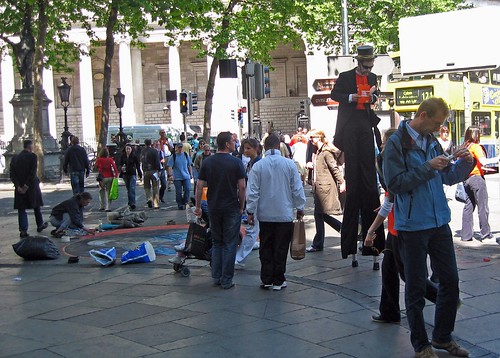
At the top of Grafton Street, something else got my attention: A life size Halo action figure. It was a promo for Halo 3 and for an XBox Live Gaming Centre on S. William Street. Didn't have a chance to check out the gaming centre, but it's now on my radar.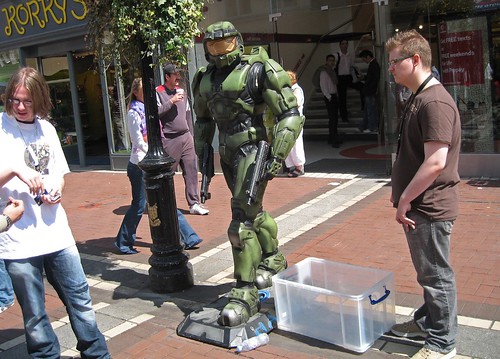
And finally, when I got to the LUAS at St. Stephen's Green, I noticed a group of TV cameras crowding around someone. I think he's a politician, probably chatting about the upcoming elections. He looks familiar. I should probably know who he is. Ooops.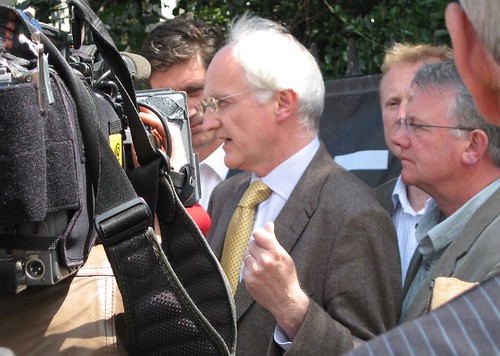
0
comments
![]() Posted by
Brandon
Posted by
Brandon
Categories: art, politics, walk through
 Ireland is well known for its historical wealth of theatrical works, boasting the likes of Oscar Wilde, W.B. Yeats, George B. Shaw, and Samuel Becket among the ranks of Irish playwrights. Kristy and I have been talking for some time now about catching a show at the Gaiety or Abbey theatres. (Looking to see Riverdance at the Gaiety sometime in July.)
Ireland is well known for its historical wealth of theatrical works, boasting the likes of Oscar Wilde, W.B. Yeats, George B. Shaw, and Samuel Becket among the ranks of Irish playwrights. Kristy and I have been talking for some time now about catching a show at the Gaiety or Abbey theatres. (Looking to see Riverdance at the Gaiety sometime in July.)
One thing we've got in the diary for sure is a free drama event that DUN Laoghaire-Rathdown County Council are hosting for two weekends this month called 'Centre Stage.' Over the course of the festival, there will be 6 shows, though it doesn't sound like they'll all be full length features. (For example, a group called the Balally Players will be performing 'scenes from' Much Ado About Nothing.)
Should be some good craic and, of course, you can't beat the price. =)
0
comments
![]() Posted by
Brandon
Posted by
Brandon
0
comments
![]() Posted by
Brandon
Posted by
Brandon
Categories: history

One of the consistent features you're likely to come across as you walk through Dublin town centre is on the corner of College Green and Grafton streets, right across from Trinity College, where Dave does his meticulous art work. I've chatted with Dave a few times and he's always happy to have a conversation. Something you might recognize pretty quickly is that Dave has an English accent. At some point, I'm hoping to ask him how long he's been in Dublin and, in particular, how long he's been working College Green.
The picture above is a new project Dave's begun where he's actually drawing on the pavement with chalk. When he's not there, it's covered up with some sort of canvas and weighed down by a few traffic cones. In my opinion, it's people like Dave who bring a personal familiarity and artistic charm to Dublin. Now, if we can just get him to do something a little more like this . . .
0
comments
![]() Posted by
Brandon
Posted by
Brandon
Categories: art
Recently, I’ve discovered a few historical sites of interest on the outskirts of South Dublin, all within a 10 minute drive from our estate. The gorgeous weather over Easter weekend afforded Kristy and I the opportunity to explore them.
First, there’s Kilgobbin Castle, located on what looks to be private property on Kilgobbin Road. However, the large gates are always open and the castle is far removed from the residence. The castle (or what’s left of it) is only a few walls overgrown with wild shrubbery and locals just think of it as a pile of rubble. However, given the height of the walls, there’s still enough there to imagine what it may have looked like when it was in use, circa 17th century.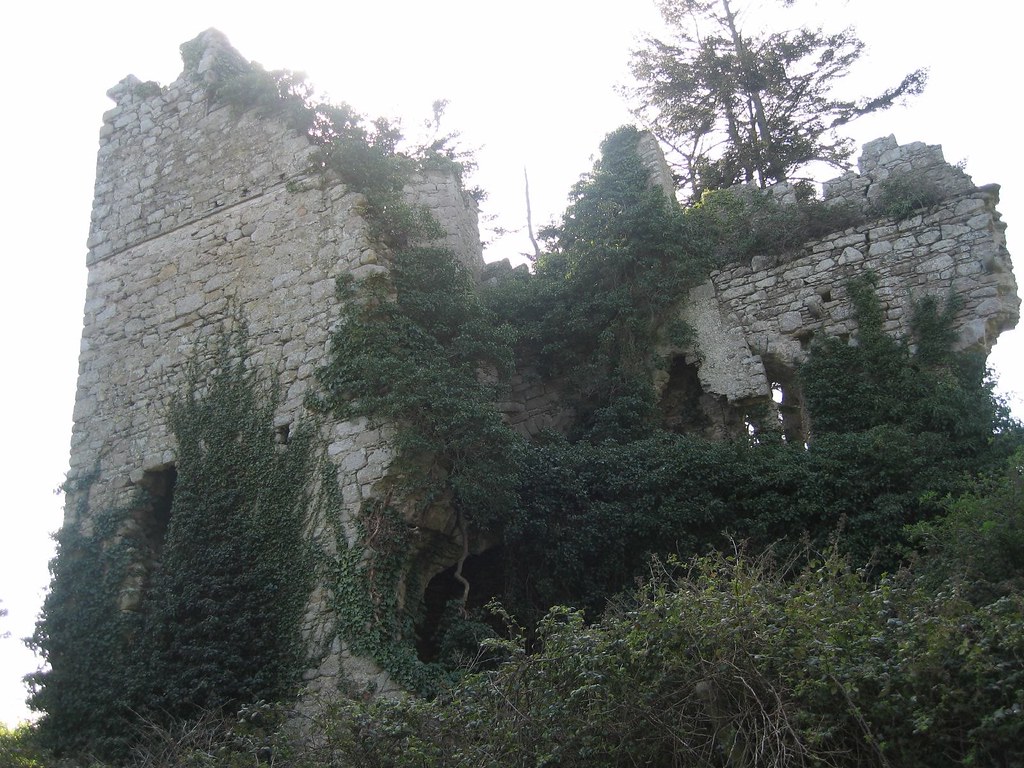
Just up the road further into Stepaside are the ruins of Kilgobbin Church and cemetery. Also at the site is a granite high cross from the 12th century which was uncovered in the early 1800’s.

Moving on past Stepaside, through Kiltiernan and down to Rathmichael is another castle known as Puck’s Castle (pictured below). Situated in a farmer’s field, it has a great view of Dublin and the bay. King James II is known to have visited the castle in 1690 after he was defeated at the Battle of the Boyne.
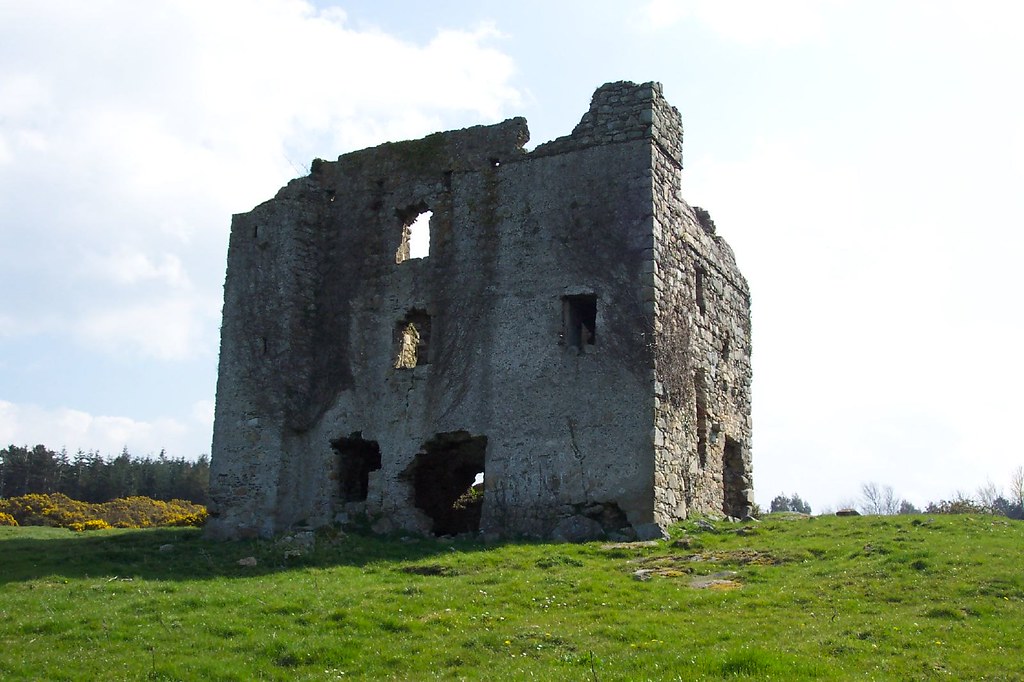
Down a little further and up a gravel road is what remains of Rathmichael Church. According to Megalithomania.com, some of the stones hanging on the walls of the church show traces of pre-Celtic Neolithic art forms. (This of course isn’t to suggest that the actual church has been around since then, given the fact that neither Christianity nor "churches" existed.) While we were there, we noticed that the wall surrounding the church yard was very much intact, though overgrown in places. The place feels very secluded, until you stop long enough to realize you can hear traffic on the M50 in the distance.
 Tom over at Megalithomania.com documents loads of these kinds of things around Ireland and even provides GPS coordinates for the ultra-nerdy. He also provides decent directions to the sites that we visited in particular.
Tom over at Megalithomania.com documents loads of these kinds of things around Ireland and even provides GPS coordinates for the ultra-nerdy. He also provides decent directions to the sites that we visited in particular.
1 comments
![]() Posted by
Brandon
Posted by
Brandon
Categories: history
It's been slow, but the process continues to move forward for Northern Ireland. (CLICK HERE for the NY Times article and HERE for the BBC.) Today, Ian Paisley (the hard-nosed British loyalist) and Gerry Adams (formerly tied to a terrorist organization) sat down at a table for the first time to discuss power sharing between the two parties. Beginning on May 8th, the Democratic Unionist Party and Sinn Fein will begin governing the UK province together, with Sinn Fein continuing to press for a united Ireland and the DUP insisting on staying tied to the UK.
In our Irish history class, the wife and I have been learning about how, for hundreds of years, successive kings of England tried to subjugate the Irish through colonization, as well as both legal and religious legislation. (In fact, in 1366 Britain even outlawed Irish people from entering cathedrals in Ireland.) From the mid-12th century on into the early 20th century, this was Ireland's relationship with Britain. It was in 1609 that the Ulster Plantation began in northeastern Ireland under James I. Lands were taken from Catholic Irish landowners and given to Protestant English colonialists.
Given the history of the conflict from an outside objective view, it's fairly easy to see how the UK's occupation of N. Ireland wasn't fair or just to begin with. However, given the situation today in a democratic society, with a small majority of N. Ireland's population preferring to stay connected to the UK, there doesn't seem to be any other realistic option but to allow democracy to run it's course. Obviously, I've simplified things down quite a bit here, but for the readers in the United States, this is the best summary I can offer (minus the bloodshed and the atrocities from both sides).
0
comments
![]() Posted by
Brandon
Posted by
Brandon
Categories: history, Northern Ireland
Early this last week, there was an editorial article from the Irish Times in which some remarkable statements made by Ireland's current Taoiseach, Bertie Ahern, were applauded. The statements were made at the end of February when Ahern spoke to a group of inter-faith representatives at Dublin Castle and expressed his concern to keep faith and religion in the public square. The Taoiseach was quoted as saying that people who were promoting “a form of aggressive secularism . . . would deny a crucial dimension of the dignity of every person and their rights to live out their spiritual code within a framework of lawful practice which is respectful of the dignity and rights of all citizens. It would be a betrayal of the best traditions of Irish republicanism to create such an environment.”
Previous to this quote, the journalist speaks of the word “tolerance” with a different kind of contempt than what we're typically used to seeing in the media. “. . . [Whereas] those who engage in such superstitions are to be 'tolerated', they are also to be regarded as engaging in a near-obsolescent and unmodern activity. Our society seems merely to put up with people who believe in God because such 'tolerance' is part of our liberal ideology.” (Surely he's speaking of European society and not Irish society!)
In one sense, this is ironic in a country where an inseparable mixture of religion, politics, and national identity has brought violence, division and deep resentment. As a result, one might be tempted to think people would be leaving their religious roots in droves here in Ireland. However, for various reasons, this is largely not the case. Irish people may be increasingly disillusioned with the institutionalized version of their national religion, but it appears that they are not ready to throw out belief in God altogether. Recently I came across some statistics from 2002 which said that of the 3.9 million people in Ireland, 500 claimed “atheism” (that's .01%!) and about 138 thousand claimed “no religion” (3.5%). Figures from the latest census in 2006 are due to be released later this year.
It might also be tempting to think that the Irish are a rather gullible, superstitious lot, caught in the grip of their antiquated embrace of religion, due in part to their tireless reaction to their British oppressors. However, a closer look reveals a much more thoughtful, well-educated understanding of humanity's spiritual impulse. The “spiritual code” that Mr. Ahern spoke of in his speech was informed by “considerable evidence that [religion] is, in fact, a natural and essential element of the human psyche,” to quote our Irish Times journalist.
Whereas many in today's world will point to the wars and other damage that religion has brought to humanity (eg., Richard Dawkins), a growing number of people recognize that religion and evil done in the name of religion are not the same thing. Apparently, that includes the Irish.
1 comments
![]() Posted by
Brandon
Posted by
Brandon
Categories: religion
Just got wind of this ITV news report from last week. It looks ahead to the Six Nations rugby match that happened this last Saturday. It's a nice little summary of the historical significance of the match that subsequently happened without any reported problems whatsoever.
0
comments
![]() Posted by
Brandon
Posted by
Brandon
Categories: sports
After having lived a few years in an English town completely bereft of good coffee shops, I've been quite pleased with the number of cafés here in Dublin. In fact, according to an article in this month's edition of The Dubliner magazine, cafés are on the rise in Ireland's capital city by 25% in the last five years. The reason for this growth is likely the amount of disposable income in the pockets of Dubliners (ie., The Celtic Tiger).
The Dubliner article also argues that pubs are a fading cultural quirk of the past and lists the stereotypical elements of Dublin's public houses: loud music, bad food (if any), and uncomfortable seating. Personally, I've been to plenty of great Irish pubs with decent food and an environment quite conducive to socializing, but for some reason I don't think The Dubliner is known for looking at the good things in Irish tradition.
So, what are the necessary ingredients to a great café? Ambiance, comfortable seating, quality food/drink, and friendly staff. This last ingredient is my own preference and is probably reinforced by a bad experience I had recently. (I realize the price for a take-away coffee is often lower, but I never thought I'd get kicked out of an empty café for taking a seat with my paper cup!)
The Dubliner brings up some other pertinent issues in a very balanced way, like the influence of globalization (hello, Starbucks!), and the efforts of pub owners to adapt to the café culture demand. Interestingly enough, in regards to globalization, the magazine article is quick to point out that, while Starbucks gets a bad rap for its obnoxious saturation marketing, they're not the only company with an eye on world domination. Ireland's own O'Brien's sandwich shops boast 300 outlets in 12 countries.
Ireland is known around the world for friendly people and good conversation, among other things. Seems to me that a thriving café scene only serves to uphold that reputation!
1 comments
![]() Posted by
Brandon
Posted by
Brandon
Categories: food
Kristy and I went into the city centre to explore today. In particular, I wanted to visit Café Irie for lunch in the Temple Bar District. This month's issue of The Dubliner magazine has them listed as the top café in the city. It's a small, second-story place across from Luigi Malones and Urban Outfitters. There's only seating for about 15-18 people or so, but the people are very friendly and I was quite impressed with the food, including the coffee. In fact, it might need to become a regular stop-in whenever I'm in the city. (No Starbucks for this Yankee.)
After lunch, we sauntered over to check out the Saturday Food Market. The smells and sights made us wish we hadn't just eaten! We already have plans to go back next Saturday afternoon, only this time with empty stomachs.
Next, we stopped by the Oxfam book shop on Parliamant street and picked up “The Collected Poems of W.B. Yeats” for €6. Then it was back through Temple Bar where we dropped in at the Project Arts Centre just in time to see a group leaving for The Rain Party. In keeping with the art theme, we wandered down to the Temple Bar Gallery and Studios for a look through Matt Stokes' documentary exhibition on early 90's “cave raves” in the UK's Lake District.
For the first time, we also finally stopped in at the Dublin Tourism churchy-looking building. I picked up the Dublin International Film Festival programme and got really tempted to purchase the required membership to the Irish Film Institute in order to get in to some of the showings. As I was looking through the schedule, I realized that it's happening during the same week that I'll be out of town visiting my brother on business in Spain. DOH! Maybe next year.
Finally, before heading back to the LUAS, we stopped in at St. Teresa's. Always a peaceful break from the hustle and bustle of life in Dublin.
3
comments
![]() Posted by
Brandon
Posted by
Brandon
Categories: art, food, walk through
My wife and I are taking an Irish history course here in Dublin and for today's class, we were taken on a tour through the National Museum. Some of the more recent (and gruesome) findings in the museum include the remains of human bodies that were preserved in various peat bogs around the country. The one we saw today was killed some 4 or 5 hundred years before the birth of Christ, yet it was so well preserved that Gardai were able to take fingerprints that were as clear as any fingerprints they take from living people today!
One of the comments by our tour guide had to do with the popular ideology of a peaceful Ireland in ages past that was something close to a utopia of sorts. I've heard other Irish folk talk about this teaching in the context of a search for Irish national identity. In some ways, I guess it's the same way with whatever country one happens to be from. Where we've come from as a collective people informs our national identity, so whatever we can do to romanticize or idealize that past is the tendency.
As for Ireland, this has to be met with the reality of human sacrifices and a certain level of "barberism," as our tour guide put it today. The pre-historic man we saw had been ceremoniously dismembered and mutilated, presumably in an effort to bring agricultural fertility to the land.
2
comments
![]() Posted by
Brandon
Posted by
Brandon
Categories: history
